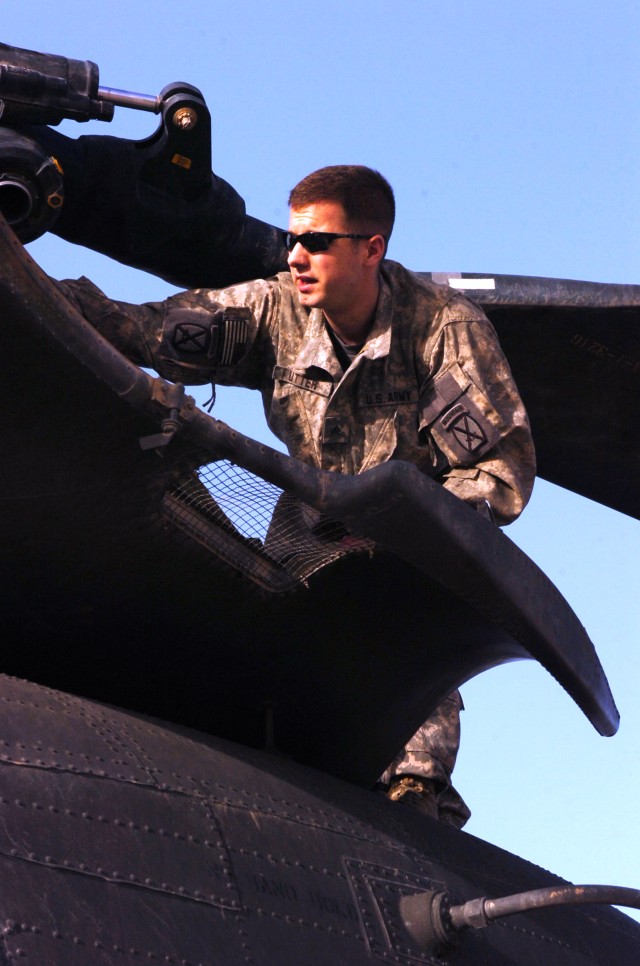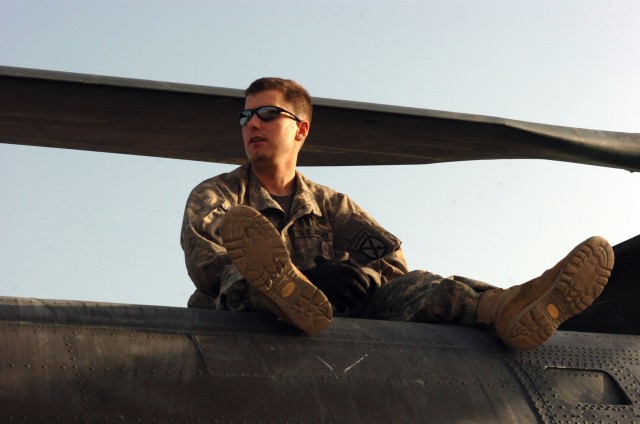Sounds of rumbles, whirrs, chops and sustained clatter aggressively compete for audible dominance within the narrow-shelled frame of a CH-47 Chinook Helicopter. These are the voices of a typical U.S. military Chinook awakening from its slumber.
For many first-time passengers, these voices are noises, threatening to deafen unprotected ears and, still, overwhelming even the protected. For the Soldiers and military personnel who operate these aircraft daily on an intimate level, these voices are clear and defined, speaking volumes of information.
One such Soldier is Sgt. Chris Utter, a Reedsburg, Wis. and flight engineer with B. Company, 3rd General Support Aviation Battalion, 10th Combat Aviation Brigade, 10th Mountain Division.
Moving about the cabin with an energetic, yet stoic, composure, Utter methodically responds to the needs of the aircraft and directs his Soldiers with jargon-laced commands and direction. There isn't a Soldier on the aircraft who doesn't possess and immediate and complete understanding of what needs to be done to make the many clamoring voices of the Chinook sing as one.
As a flight engineer, Utter supervises and maintains the aircraft with his crew, performing pre-flight tests and checks to ensure the safety of his passengers, crew, and the pilots during the upcoming mission.
Utter took on this duty with an involved affection during the early years of his 12-year military career.
According to Utter, the Army's mission in the skies was not always what he wanted to do with his career.
"I originally enlisted in the artillery field," said Utter, in a flight-crew break-room. The pilots and crew members laugh heartily and trade stories all around.
The inspiration for making the leap from artillery to flight engineer was one which presented itself during a slow period for his military profession, Utter admitted.
"One event that did trigger an interest for me was when I was deployed to Albania in support of Task Force Hawk," Utter said. "They really didn't have a mission for the artillery battalion I was assigned to, so we ended up pulling a lot of guard duty around the airfield."
"One day I was up in the guard shack with all my gear on, sweating to death, but I look over my shoulder and not far behind us is the parking area for a lot of the aircraft. One of them happened to be the Chinook unit," Utter continued.
From that moment onward, according to Utter, the Chinook has remained "the only one for me."
"While I enjoyed the camaraderie, the professionalism, in the artillery field, the job here on the aviation side of the house is much more satisfying for me," Utter said.
Serving at his first duty station as a flight engineer at Fort Campbell, Utter, despite having served in the U.S. Army for three years, felt his as if he were beginning his military career all over again.
"I started off my career as a ground maintainer and paid my dues and I got a crew slot while at Fort Campbell," said Utter. "It was a whole new progression starting off again. I had to start all over on the crew side and get a whole new knowledge base."
A part of the 10th Combat Aviation Brigade since May 2007, Utter has found himself surrounded by professionals who help him further his professional skills.
Utter attributes much of his technical know-how to the crew and pilots who serve alongside him, in support of his new mission supporting Operation Iraqi Freedom in northern Iraq.
"All of our pilots-every last one-are incredible," Utter said, simply. "The knowledge base these guys have is just incredible. Just working with them and picking their brains as best I can gives me a lot to learn from."
Working in a field he loves, Utter tackles every task Chinook operations require of him with apparent enthusiasm.
"I absolutely love this aircraft," said Utter, with a grin. "It's such a strange looking aircraft and it doesn't operate like any other rotary-wing helicopter."
"When you're plugged in and you hear the aircraft, it sounds like chaos," Utter said. "It's really chaotic if you don't know what's going on."
Following the inspections and preparations, the Utter and his crew finally begin departure. The Chinook lifts off the landing pad and the pilot pauses mid-air. The noises, sustained and loud, cause chatter between the pilot and crew.
The "strange looking aircraft's" raucous voices, seemingly speaking a language meant only for those closest to them, may sound foreign to passengers, but Utter knows. Utter speaks to the pilot through the headset within his helmet, the two offering their interpretations of what the aircraft is saying.
"It's so complex, I don't think anyone has a complete understanding of what's going on, but you can get to a level where when one of the sounds of the aircraft changes you almost know what it was that caused the change."
Utter and his crew know.






Social Sharing